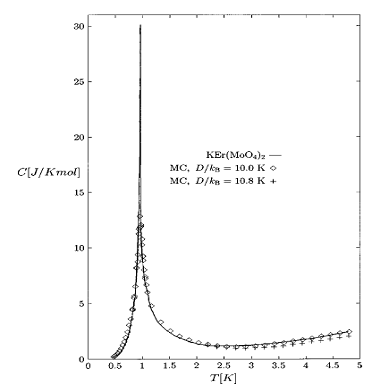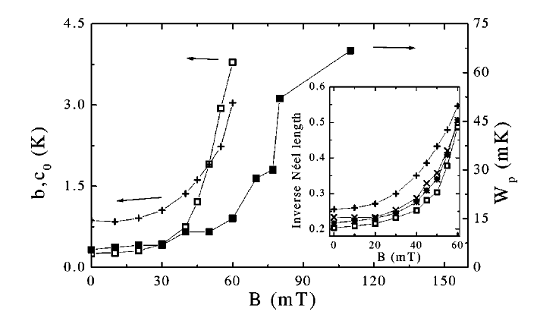TWO-DIMENSIONAL ISING MAGNETS
A. Orendáčová, M. Orendáč, E. Čižmár, A. Feher.
Rare earth dimolybdates with a general formula AR(MoO4)2, A = Cs, Rb, K and R = Dy, Tm, Er, Gd, Nd, ... represent magnetic insulators with a layered crystal structure. Magnetic ions are arranged into a square lattice within bc layers. Since the main mechanism responsible for the magnetic correlations is dipolar interaction, a quasi-one dimensional magnetic structure is formed, arising from the different distances between the ions along b and c directions. The crystal field generated by a local surroundings of R3+ ions determines their predominantly Ising-like or xy character associated with g-factor anisotropy.
Experimental studies of CsDy(MoO4)2 showed that the magnetic behaviour of this compound can be approximated by a S = 1/2 Ising model on the square lattice with |J/kB| » 1 K and Tc = 1.3 K [1]. Theoretical studies of the magnetic structure of CsDy(MoO4)2 within a pure dipolar approach showed that the ground-state spin configuration should consist of ferromagnetic chains running along the c-axis with the magnetic moments oriented along the same axis while the magnetic moments in the neighbouring chains are oriented antiferromagnetically [2]. The energy of the ground state is very close to the energies of different spin configurations. The closeness of the energies can cause sensitivity of the magnetic structure to local lattice imperfections which could stabilize some of the low energetic phases. The proneness of the system to form coexisting magnetic phases – droplets below the phase transition might explain the origin of the relaxation processes observed in CsDy(MoO4)2. Recently, elastic neutron scattering studies of the magnetic structure have been performed down to 300 mK [3]. The investigations revealed the coexistence of different structural domains and strong relaxation processes in the ordered state which were assigned to a critical slowing down of fluctuations enhanced in Ising systems. The authors argue that during relatively fast cooling through Tc the short-range order droplets are “frozen” in the ordered phase – matrix, slowly relaxing to the “matrix” order.
Chain-like character of the magnetic structure of KEr(MoO4)2 was predicted by dipolar calculations [4]. Within the pure dipolar approach, the ground state of KEr(MoO4)2 consists of ferromagnetic Ising chains coupled antiferromagnetically with the moments oriented along the c-axis. Motivated by these results, we analysed the specific heat data in the vicinity of a phase transition by the model of coupled S = 1/2 Ising chains [5]. Following the philosophy of the cluster-like domain walls excitations in KEr(MoO4)2, we performed detailed analysis of specific heat data in the paramagnetic and ordered region using classical Monte Carlo simulations [6]. Unlike the pure S=1/2 Ising model, in our theoretical model we considered also the upper Kramers doublet which is separated from the ground doublet by the energy » 20 K, estimated from EPR studies. Using effective spin 3/2 and the crystal field splitting, KEr(MoO4)2 can be treated as a realization of a quasi-one-dimensional Blume-Capel model with spin 3/2. This model yielded excellent description of zero field specific heat data in the wide temperature range (Fig.1). The quantitative deviations between the Blume - Capel (BC) model predictions and KEr(MoO4)2 specific heat apparently manifesting in nonzero magnetic field, triggered further research taking into account demagnetizing effects. The calculation of KEr(MoO4)2 specific heat within a pure dipolar approach using mean field approximation and including real sample shape effects, yielded a better quantitative agreement than previous BC model [7]. The behaviour of KEr(MoO4)2 in longitudinal magnetic field below a phase transition has been studied experimentally and theoretically in ref. 8.

Fig.1
The significant influence of interchain correlations required the using of a two-dimensional Ising S = 1/2 model for the analysis of low-temperature experimental results focused at the mapping of the magnetic Bc vs. Tc phase diagram in longitudinal field. Our studies revealed the coincidence between the critical behaviour of a 3d dipolar Ising magnet on the approximately tetragonal lattice (c/a > 2, where a represents inplane spin distance and c stands for interlayer distance) and the Ising model on the square lattice with only nearest-neighbour exchange interactions. The phase diagram investigated at temperatures down to 0.5 K and fields up to 50 mT suggests metamagnetic behaviour with expected tricritical point at about 0.5 K and 50 mT. The phase transitions from the vicinity of the point are accompanied by extreme widening WPof experimental and theoretical specific heat peaks. Furthermore, MC calculations show that the increase of the peak width correlates with the behaviour of average domain size in magnetic field (Fig.2).

Fig.2
We believe that experimental study of relaxation processes at low temperatures in longitudinal magnetic fields might indicate a crossover between two different relaxation regimes associated with different ordering processes above and below the tricritical temperature.
[1] P. Stefányi, A. Feher, A. Orendáčová, E.E. Anders, A.I. Zvyagin, J. Magn. Magn.
Mater. 73 (1988) 129.
[2] A.G. Anders, V.S. Bondarenko, S.B. Bordovskij, A. Feher, A. Orendáčová, Low
Temp. Phys. 23 (1997) 895.
[3] E.N. Khatsko, A. Zheludev, J.M. Tranquada, W.T. Klooster, A.M. Knigavko, R.C.
Srivastava, Fiz. Niz. Temp. 30 (2004) 184.
[4] A.G. Anders, S.V. Volotskij, O.E. Zubkov, Fiz. Niz. Temp. 20 (1994) 131.
[5] A. Orendáčová, M. Orendáč, V. Bondarenko, A. Feher, A.G. Anders, J. Phys.: Condens.
Matter 10 (1998) 1125.
[6] D. Horváth, A. Orendáčová, M. Orendáč, M. Jaščur, B. Brutovský, A. Feher,
Phys. Rev. B 60 (1999) 1167.
[7] D. Blažek, A. Orendáčová, M. Orendáč, Czech. J. Phys. 52 (2002) A297.
[8] A. Orendáčová, D. Horváth, M. Orendáč, E. Čižmár, M. Kačmár, V. Bondarenko,
A.G. Anders, A. Feher, Phys. Rev. B 65 (2002) 014420.